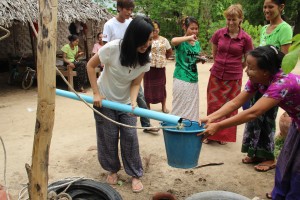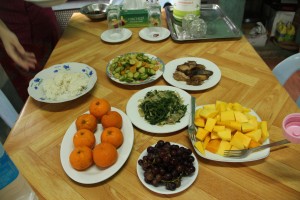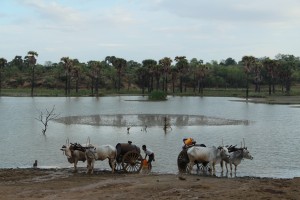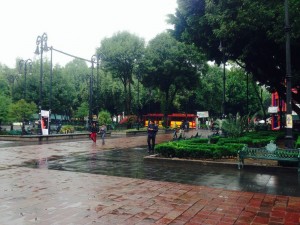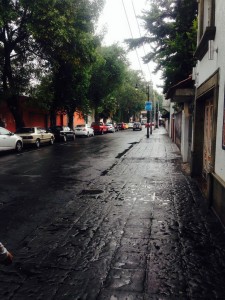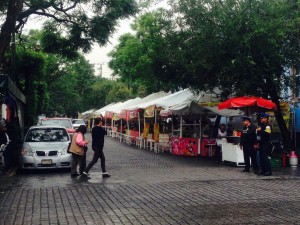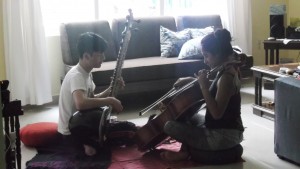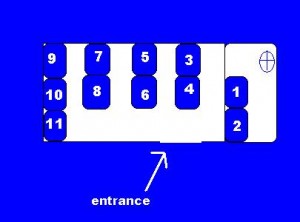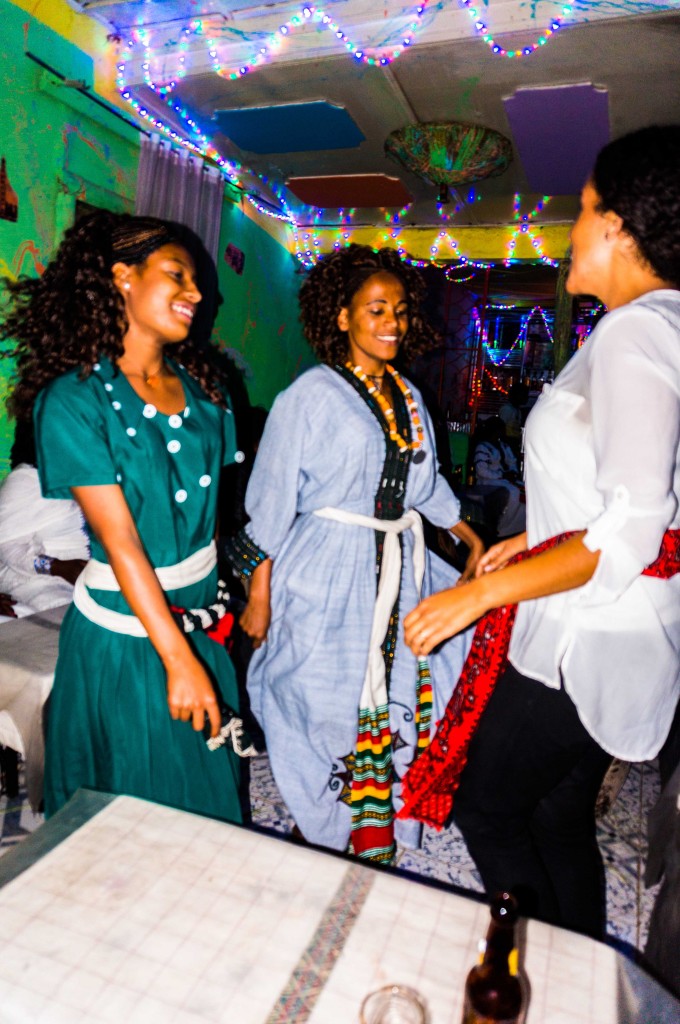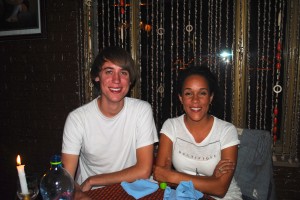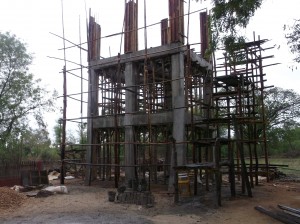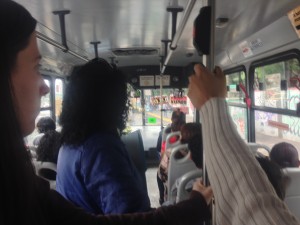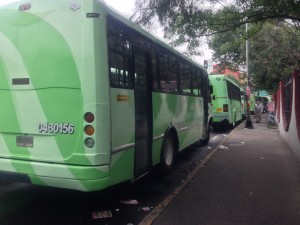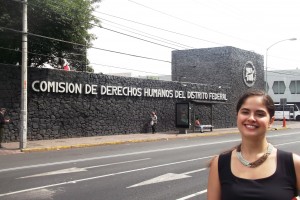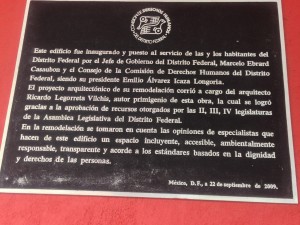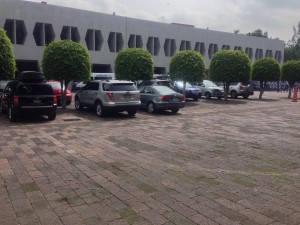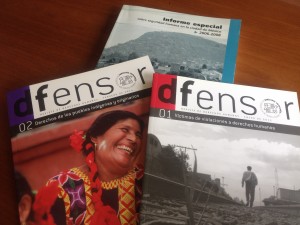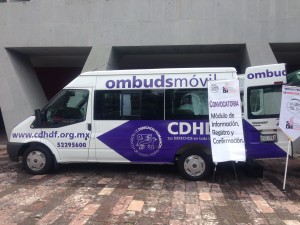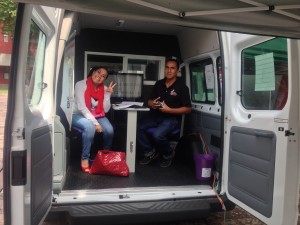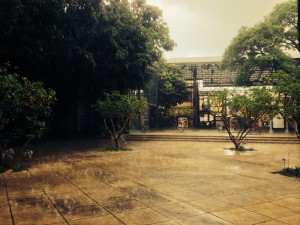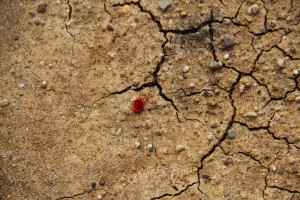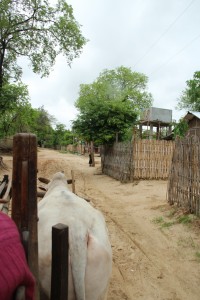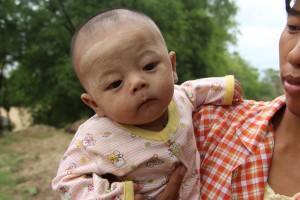Archive for June, 2014
Learning our way through Addis
Posted by Katie Petitt in Ethiopia, Katie Petitt on June 25, 2014

Phoenix, Pushpa and I at the Bete Maryam Mausoleum

Driving around the streets of Addis Ababa
Our director, Pushpa, came in Saturday night. Since then, the 3 of us have been on the move. We have made our way though restaurants, markets, hotel lobbies, parks, squares and mausoleums. We have sat in UN offices, NGO offices, university offices and in plenty of traffic. We are mastering this ever growing city and it is only week 2! Mastering may be a strong word, but I am proud to announce Phoenix is the minibus master and that has to count for something (see his blog).
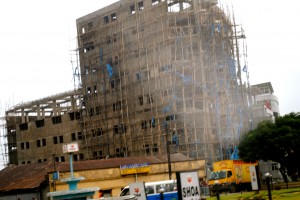
Countless of these buildings are being constructed as the city grows and expands.
Really, I wish you could see this city. It is beautiful. If you talk to Pushpa and Phoenix, they will tell you I say “wow” almost every 20 minutes. I am in awe of the old architecture, the food, the people and the colors. The new architecture is equally impressive because there is just so much of it. Today we were riding around and to our right we saw at least 10 huge buildings under construction. Addis Ababa is a rapidly developing city and I have had several native Addis dwellers say to me that they drive around and always find new areas of the city because it is constantly growing. I think we, like these locals, will continue to learn and explore the city and keep finding new things.

Breakfast, coffee and a shoeshine at these street-side vendors

The usual bustle outside of St. Stephen’s Church
This investigation is already underway. We have made so many contacts these last few days and we will be doing quite a few interviews around the city and throughout the country. Our first one this week will be on Thursday. We hope to take pictures of people lining up for water because they have no access in their homes. This is in the far northern part of the city, and it is not an isolated case. We are learning more and more about how the rapid development of this expanding city is affecting the water supply.We have even heard of people who have been living for 5 years without water during the daytime. Water issues, it seems, are prevalent not only in the rural areas or drylands, but right here in the water-rich capital.
We are slowly learning our surroundings and about the water issues Addis is facing. Development is playing a role in this issue, yet the people seem hopeful for the future. In our upcoming interviews we want to look at how the water situation now will play a role in that future.

Looking out at the city from Meskel Square
Reflection of Dry Zone
Posted by Namsai Wongsaeree in Burma, Namsai Wongsaeree on June 25, 2014
Eight days in dry zone was probably one of the most challenging experiences in my life, but also the most meaningful ones. There was so much that I have observed, listened, and learned. I am thankful for the stories the people have been openly sharing with us.
Weather is, no doubt, one of the most important factors in human lives. Having the privileges to somewhat “control” the weather, either by air conditioners or heaters, makes me take the powerful effects of weather for granted. Being in the dry zone, where my body and brain could only barely function because of the heat and humidity, I finally realize ‘for real’ for the first time in my life how tremendously the weather affects us and how little (if not none at all) we can control the weather.
Climate change is a huge problem. The problem that none of us can overcome without serious combined efforts.
To sustainably tackle the problem of climate change and the lack of water, people of dry zone are trying. Dams are being built, ponds are being dug, and pipelines are being installed. Hundreds of trees are being planted, but unfortunately, not many will survive. Not enough water for consumption, not enough water for household usage, not enough water for irrigation also means not enough water for trees to grow. These people are seeing some of their efforts going to waste, yet they won’t stop trying, they won’t stop hoping…
The people are strong. They are very strong. Yet, it is still not enough.
I am now back in Yangon drained and unwell. I am getting some rest and recovering. Yet the people there are still trying…
Coyoacan
Posted by Jessica Sanchez in Jessica Sanchez, Mexico on June 24, 2014
One of my favorite places in D.F. is in Coyoacan, a delegation Northeast of UNAM, approximately 10 minutes by trolebus, from my apartment. At its center, a plaza bursts with vibrant colors. Restaurants, bars, and small shops form two large squares, divided down the middle by a small avenue. Inside these squares, benches, trees and lush shrubs decorate the plaza. On a rainy day like today, water fills the pores on the stone grounds. The wet soil smells of comfort and the surrounding greenery is rich with life.
This place, so different from anything in the US, feels like home. Walking the streets of Coyoacan I see beautifully decorated buildings, each adjacent to the next, an endless array of tones, personality and design. Uniform and disorderly, in their natural state.
At the Coyoacan Market, there are rows and rows of small posts, selling everything from candy, to flowers, to fruit, to toys, meat, and meals ready to eat. At every turn someone pops out of their post to greet you with a smile and ask if there’s anything you’re interested in. There’s a welcoming buzz in the background, of people shopping, locals selling, laughter, and gossip.
Here, I stop by my favorite fruit stand, where the owners know my face and my order almost by heart. The fruit here is sweeter than anything I’ve ever had in the US. My recommendation: Banana, strawberries, guava, figs, papaya, mango, all diced up and topped with honey and granola. I always order just one more thing: 1 liter of fresh squeezed grapefruit juice, with just a bit of orange juice for sweetness. It’s heaven and since I arrived in Mexico, Coyoacan has formed an integral part of my routine and the tasty fruit, a daily part of my diet.
The house of musicians
Posted by Ainhoa Martinez in Ainhoa Martinez, Mexico on June 24, 2014
It’s been more than 2 weeks since I landed in Mexico City and every day I discover new qualities of the people who are around me, which actually fascinate me.
The area where I am living is close to the School of Music and because of that, it is easy to come across with musicians or music students. In fact, two of my roommates are studing music: Hugo plays the piano and Carina plays the Cello.
When it rains heavily here, it is almost imposible to work on the field (floods, traffic jams, electric storms…) and some days we just try to gather information and write to contacts from home.
Last day, while I was studying important facts about water conflicts in Mexico I had the opportunity to join Carina and her Sitar player friend in their rehearsal afternoon.
Becoming a professional musician requires countless hours of rehearsals, so that’s what they did: 8 hours of non-stop music. Thank God I liked it, this is not a house for those who don’t like listening to music.
It was a nice afternoon: it was raining outside, Carina prepared her delicious black tea with ginger and cinnamon and lighted some incense.
Music and art cultures are truly rooted in Mexico City and you can find a lot of free daily events in the city center.
This reminds me of when I started playing the guitar, but had to leave it because of the lack of time. I don’t see myself becoming a professional musician, it is just a hobbie. But I hope Carina succed in her field, she is a talented woman and a dreamer. And who knows, maybe in the future I’ll be sitting in an auditorium enjoying one of her concerts.
Please, enjoy this short clip showing their talent:
Firengi in the Minibus
Posted by Phoenix McLaughlin in Ethiopia, Phoenix McLaughlin on June 22, 2014
I beat a record tonight. It was only a personal record, but a significant one nonetheless. I am talking of course, about the amount of human being fit into an Addis minibus.
I say “amount of human being” instead of “number of people” because that record was not beaten. That remains at 20 people fit into a 12-passenger van. However, that number had previously included teenage girls and small children who fit more easily into the small space. The record set tonight was the squeezing-in of 20 full-grown, fairly large men, including myself, into a van headed from Bole to Mexico.
For reference, here is what the layout of the van is supposed to look like:
And here is the reality (numbered in order of non-seats typically taken first):
It was truly something special.
That statement is not made entirely in jest either—I do think there is something important about cramming into a sputtering van with the rest of the town. This occurred to me largely because that record was set as I was on my way home from the first bona fide tourist trap I’ve experienced in Addis Ababa.
Due to some cab driver miscommunication, Katie, Pushpa (who just arrived!), and I accidentally ended up at a restaurant that we had tried—and failed—to get to last week. It came well recommended by the internet, so we figured it must be good. The food was excellent no doubt, and they put on a music and dance show too. But we certainly paid the price, ending up with a bill about three times the normal amount for dinner here.
The restaurant was packed to the brim with people, including a group of about 30 Americans sitting next to us. It may seem like a silly qualm, but I couldn’t help but think later that it was sad that they probably wouldn’t get the experience of smashing themselves into a van filled with Amharic and poorly vented exhaust fumes.
There are a lot of places my mind could have gone from here. I have been trained to connect everything to broad social implications, and there was no shortage of such implications to be had from contemplating the experience of this group of Americans, who were here on a charity/mission trip. At the very least, I could have thought about the significance of their presumed lack of experience with a popular form of local transportation.
But honestly, my mind was blank in those places. I just wish they had the chance to stuff into a minibus full of strangers.
I don’t know what, if anything, riding on minibuses has taught me, what it means, or if it is useful. But it feels important. At any rate, it’s kind of fun, and you certainly don’t get to do it everyday back home.
I had the same thought regarding the dancing we were all watching in this restaurant. At one point they did a dance that was in a traditional Northern Ethiopian style. When Katie and I were out on my birthday, we happened to be led to a small bar in a isolated part of town that was full of this traditional Northern Ethiopian song and dance, and it was amazing. The way the dancers moved their bodies was nothing short of incredible, not to mention surreal; it was if someone possessed was popping and locking. The dance we saw in the restaurant simply did not display the intensity or personality of the dancing we saw in that bar. Again, I don’t know what there was to learn from it, but I wish the big group of Americans could have had that experience.
Really, I wish everyone could have that experience. Seeing it was cool. It was fun. It was interesting. And yet so few people around the world will get to see it, let alone get there in a packed minibus.
I suppose my only recommendation to you, readers of this blog, is to come and do it yourself.
One Week
Posted by Katie Petitt in Ethiopia, Katie Petitt on June 21, 2014
I just got done talking to Nebiyu, a journalist student working part-time at the hotel I am staying at. He has been nothing but helpful and hospitable. After I told him why I am here in Ethiopia for the next 2 months, he said, “The people are with you”.
I couldn’t have put it better myself. I have been here for one week now and Nebiyu is only one of many Ethiopians who have bent over backwards to help me, both personally as I set up my life here, and professionally with this research project.
This first week has been jam packed with coffee dates, dinner dates, meetings and any other form of gathering one can have. We have been here a short time and we could not be more pleased with our progress. Here was our week to help illustrate just how many wonderful people we have met.
Friday – Phoenix’s 21st birthday! We met some nice local guys who taught us how to celebrate birthdays Ethiopian style!
Sunday– We left our very nice hostel on the southern part of town to move into our new place. Joannes, the manager of the hostel was such a sweetheart!
Monday– I left the new place because it wasn’t a good fit. Our housemate Joel offered to take Phoenix and I around the neighborhood to look for new places. That night we had coffee at Kaldi’s (Ethiopian version of Starbucks) with a new friend Marta. She was kind enough to travel through rush hour traffic after a long day of work to make us feel welcomed.
Tuesday– A flood of amazing people entered my life as I moved into a small hotel with a very friendly staff and I found 2 really great cab drivers. Our first big breakthrough happened when we met with the lovely Hermella that afternoon. Hermella and her team of volunteers started a local non-profit called Drop of Water. This organization builds water wells to help support communities who do not have access to clean water. http://www.dow-dropofwater.org/
Wednesday– Phoenix and I finally had time to research water organizations here in Ethiopia. There are a lot! For dinner we met up with Abby who is from the States and is working for International Water Management Institution. She was so helpful in telling us about IWMI’s work here and she gave us all kinds of tips on life here in Addis. http://eastafrica.iwmi.cgiar.org/
Thursday– We had two very successful interviews with Hermella and Joel about their connection with water here in Ethiopia and why they started Drop of Water. Two very inspiring young people! For coffee we met Billene, who is a UPeace alum and inspiring in her own right. She gave us lots of advice and leads on who to contact for our research.
Friday– We spent the day setting up meetings for the coming week. Our director Pushpa is coming and we are hoping to make a lot of connections with people who are working on water issues while she is here. Our search for housing continues but has led us to meet a lot of really great people, both locals and foreigners. Lucky for us, a lot of these people work in international organizations and have given us leads on whom we should talk to for our project.
Saturday– I had coffee with a local masters student, Jerusalem. She just defended her research on water pollution of a nearby river. She has been very accommodating and knows a lot about the water issues in this country.

A typical day- eating and working
The people here have been so supportive of what Phoenix and I are trying to do. The two of us are quite hopeful about the stories we will be able to share with you in the coming months.
All I buy is water…
Posted by Allison Collender in Ally Collender, West Bank on June 21, 2014
Every time I go outside, I am constantly thinking about when and where to buy a water bottle. I feel like all I buy here is something to drink.
Surprisingly, for a place that has so many issues with water, I can buy a water bottle for less than $3. Everything else here is expensive, especially food – average meals cost about 50 shekels (about $15). But water seems to be in abundance everywhere we go.
Today, while walking around Bethlehem, I stopped in a supermarket and grabbed a 1.5 liter water bottle, and when I went to the register the cashier told me I only had to pay 4 shekels. That’s about $1.15. I was floored – I knew water was cheap, but I wasn’t expecting it to be that cheap. Most places charge around 8 shekels for the same bottle.
We’ve heard stories from various people talking about how difficult it is to get water. People go months on end without having access to running water in their homes. They have to buy water off the black market just to be able to wash their dishes and take a shower. They spend time and money towards building illegal cisterns, only to be forced to destroy them when caught.
Yet all I have to do is spend a few shekels for a large water bottle. I can return to my apartment and know that I can brush my teeth before I go to sleep tonight. I can wake up in the morning and shower without thinking twice.
It’s amazing how traveling a couple of miles can so drastically change your access to such a precious resource.
There is much we can do together…
Posted by janine joyce in Burma, Janine Joyce on June 21, 2014

Ywar Tan Shae village water pond that has been dug deeper and expanded with overspill systems and water ways. Ready for the rain. Dry Zone Myanmar.
Climate Change, yes it is. Yet there is much that we can do to support the people who are at the knifes edge of this.
A well for a small number of households costs US $ 300. A massive reservoir pond US $7500. The people happy to give the back breaking labour in the brutal heat and what limited money they have for these projects. But they need partners. Because the scale of this is too big for one small community on its own.
The NGO’s are able to get the money to the people and the strategic skills and planning processes to manifest these big engineering projects. I have been really impressed by the bottom-up planning by the villagers alongside Action aid Myanmar. The village book is a comprehensive document that shows the needs, the resources and the vision for the community. When the money comes the projects seem to happen efficiently and quickly…
The people have lived 2oo to 400 years in the dry zone and they have the knowledge for facing this territory. They understand each other and know the values of cooperation and unity. Yet this territory has changed.
The rain system has changed, the trees are dying and the river beds are empty. The wells have to be dug deeper. When the rain comes it is too heavy for the land.
Like us all they want the best for their children and community. They want their children to go to school, they want to be able to take their people to the doctor and most of all they need water.
They are working to develop ways of storing the flood water when it comes.
They are managing water that has changed from sweet to salty.
They are changing their crops and numbers of animals according to the lack of water.
They are conserving water.
They are migrating to other countries to seek work.
They are filtering and boiling their water to try and not get sick.
They are separating the animal and human access from the water ponds.
They are replanting trees and but at a slower rate than the coconut and tutty trees are dying.
They are watching new plants that they have never seen before growing on their land.
The men, women and children are spending the 4 hours a day gathering water and waiting whilst everyone takes a turn at the well…before school…
They are brave as they recall the rivers and streams and forests of 43 years ago; and the acres of sand and empty water ways now. Some but not all will refill when the monsoon comes.
But it is late again… It is often late…
They are saving money and putting what little they have into community projects.
They know what they need. They need pipelines to bring the water to their homes. They know that electricity will help. They know that the roads will be useless after just a few days of rain once it comes. The much needed rain will bring more problems.
They give easily to each other without counting the cost or expecting in return. They need partner donors who can do the same. The engineers are amazing here. They achieve much on so little. Nothing is taken for granted and nothing is wasted.
A visit to D.F.’s Human Rights Commission
Posted by Jessica Sanchez in Jessica Sanchez, Mexico on June 20, 2014
Today, Ainhoa and I tried yet another mode of transportation. Called a, “micro” or “pesera” these are independent buses that travel to various destinations and cover routes not frequented by government transportation systems.
One of these “micros” transported us to D.F.’s Human Rights Commission (CDHDF), a local organ with its foundations in Mexico’s constitution, and an authority autonomous of the local and federal government. I was pleasantly surprised by the Commission’s atmosphere and quickly noticed a stark contrast between it’s environment and that of CONAGUA, which we visited this past monday. Not surprisingly. I can really only think to describe our interaction with CONAGUA as bureaucratic.
CDHDF on the other hand was quite the opposite. I’ve passed the Commission numerous times throughout my time in Mexico, it happens to be across the street from one of my favorite parks in D.F., called Viveros. From a major avenue, Universidad, the Commission welcomed us with big bold letters. Built to reflect its theme of transparency, its open spaces contain plenty of glass, both inside and out, full of friendly-faced staff and citizens waiting to be assisted. We were greeted with open arms by a Director, who made every effort to answer our questions and provide us with the Commission’s materials. He informed us that it’s the Commission’s job to assist any individual, free of charge, on human rights issues, whether they walk-in, phone-in, or file a claim online.
We got to see the Commission’s new Mobile Ombuds vans, that are to travel around the city for individuals to receive assistance. They basically look like mobile offices, as pictured below.
I left the Commission with a feeling of excitement. Glad to know we’ll be returning soon and hoping to speak to many others. I guess that’s the difference between visiting an organization who sees water rights as a human right, CDHDF, as opposed to an organization that sees water simply as resource to be distributed.
After we left, we stopped for a bite to eat nearby right before a heavy rainfall. Left without an umbrella, we were stranded for a while inside a coffee-shop.
This is not the first time the rain keeps us waiting, and I’m quite sure it won’t be the last.
Life in Dry Zone
Posted by Namsai Wongsaeree in Burma, Namsai Wongsaeree on June 19, 2014
It has been five days since we have been in the dry zone of Myanmar. As the name “dry zone” suggests, this area receives minimum amount of rainfall and access to water resources seem to be the biggest issue.
As soon as we arrived, despite the rainy season, I can see clearly that the land is dry and sandy. Tree leaves seems to be smaller in order to adapt to the weather. The weather itself is extremely hot even comparing to Yangon where we departed from.
I have been learning so much in the past few days. I have been so welcomed and well taken care of by everyone here. “You should just stay with us” and “You are welcome back anytime” have been told to us over and over from the villagers we visited. Every village we visit, there are always food and drink offered to us (some even packed snacks for us!). People waving fans trying to get rid of the flies for us, people trying to hold umbrellas for us…
I am very thankful. I have been very blessed and now I wonder what I can do for them.
Though their communities are very strong and they are pulling together all the resources they have got, people here really need help. They need help from external actors and the international community. We have been asked to share their stories, their difficulties dealing with the lack of water. Hours and miles per day they have to go carry the water, the poor quality of water they face, the time they could have used to do some other productive works, classes the children could have gone to, babies the mothers could have been looking after…the list seems to be endless.
Surprisingly, many of these stories are told with laughter. It is just wonderful to see how they support and understand each other. I truly believe that the world has a lot to learn from them.
It has been raining here in the dry zone.
“You bring good luck, you bring rain with you”
I really wish I could…
ps. photos to come when WiFi allows me…
